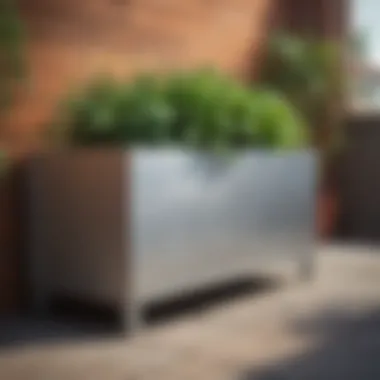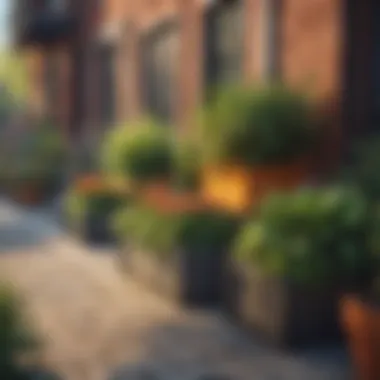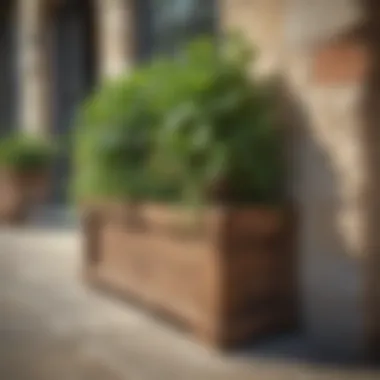Exploring Versatile Backyard Planter Box Designs


Intro
Backyard planter boxes have surged in popularity, offering much more than just a place to house plants. They represent a unique intersection of functionality and creativity, helping homeowners express their gardening style and vision, regardless of the size of their outdoor space. With their versatility, these structures can accommodate everything from vibrant flowers to herbs and vegetables, enriching the environment and contributing to a sustainable lifestyle.
As urban landscapes continue to expand, the importance of utilizing every available square inch of space becomes apparent. Planter boxes present a perfect solution for apartment dwellers with limited outdoor access or homeowners with small backyards. Additionally, they serve a vital role in eco-friendly gardening practices, helping to combat issues like air pollution and urban heat.
This article intends to explore the various dimensions of backyard planter boxes, shedding light on their aesthetic and practical implications for modern gardens. From styles and trends to tips on plant selection and maintenance, we will guide you through the multifaceted world of these essential gardening accessories. Let’s dig into how planter boxes can not only beautify your outdoor zone but also cultivate a deeper appreciation for nature right at home.
Prolusion to Backyard Planter Boxes
Backyard planter boxes serve not just as stylish additions to outdoor spaces, but also play a crucial role in modern gardening practices. They provide a controlled environment for planting, allowing homeowners to cultivate everything from vibrant flowers to fresh herbs and vegetables. The importance of backyard planter boxes lies in their versatility and adaptability to various gardening needs. Whether one has a sprawling garden or a compact balcony, they can find a planter box that meets their unique requirements.
Definition and Purpose
A backyard planter box is essentially a raised bed designed for growing a variety of plants, typically constructed from materials like wood, metal, or composite materials. The purpose of these boxes extends beyond aesthetics; they create a favorable growing environment. When you plant in a box, you have the ability to customize soil conditions, irrigation systems, and sunlight exposure. This control enables gardeners, whether novice or experienced, to coax plants into living their best lives, catering to specific needs and climates.
Together, the beauty and functionality of planter boxes enhance the outdoor experience. They can be arranged in various configurations, making them suitable for any space. Furthermore, they are effective in addressing common gardening concerns, such as soil drainage, pests, and even mobility for those with limited physical ability. Indeed, planter boxes ensure that gardening remains accessible to everyone.
Historical Context
To understand the significance of backyard planter boxes today, it's worth exploring their history. The use of raised beds for planting dates back thousands of years. Ancient civilizations, including the Egyptians and Mesopotamians, utilized elevated areas to optimize drainage and soil warmth. Fast forward to the Middle Ages in Europe; we see the emergence of kitchen gardens featuring raised plots, enabling families to grow food closer to their homes.
In recent times, with the rise of urban gardening and a growing interest in sustainability, planter boxes have made a comeback. These structures adapt well to various urban environments, allowing city dwellers to engage in gardening despite limited space. Hence, the historical progression emphasizes not just aesthetic values, but the necessity of adapting to different living environments and cultivating plants effectively.
"Planter boxes embody a blend of form and function, transforming ordinary yards into extraordinary gardens."
Thus, these boxes stand as symbols of resilience and creativity throughout gardening history, marrying practicality with design in modern landscapes.
Types of Planter Boxes
When it comes to backyard gardening, the variety of planter boxes available today is as vast as the creativity of gardeners. Each type of planter box serves a specific purpose, enhancing the outdoor environment while catering to various gardening styles. With their unique designs, functionalities, and advantages, choosing the right kind of planter box can be instrumental in maximizing one’s gardening experience. Whether you're looking to conserve space or make a statement, understanding these types can streamline your selection process and help you achieve your gardening goals more effectively.
Raised Garden Beds
Raised garden beds have carved out their niche in modern gardening. These boxes are typically elevated off the ground, created with a frame made of wood, metal, or other materials. They offer numerous advantages, including better soil drainage and easier access. Maintaining a healthy growing environment becomes less of a headache since these beds provide a range of conditions tailored to your plants' needs.
One key benefit is that they allow for control over soil quality. By using well-drained and nutrient-rich soil, gardeners can cultivate vegetables, herbs, and flowers much more successfully. Plus, the height of raised beds can reduce bending and kneeling, making gardening easier on the knees and back.
Benefits of Raised Garden Beds:
- Improved drainage and aeration
- Customizable soil composition
- Less compaction than traditional garden ground
- Accessibility for the elderly or those with mobility challenges
Vertical Planters
Vertical planters represent an ingenious approach to gardening, especially in compact spaces. By stacking plants upward, these planters effectively maximize vertical space, turning bland walls into green canvases. Space-saving and visually appealing, vertical planters allow for a diverse range of plants—herbs, succulents, or even strawberries can flourish in these setups.
Moreover, the vertical arrangement can improve airflow and sunlight exposure, which benefits overall plant health. They can be constructed from various materials, ranging from repurposed pallets to built-in shelves, making them an economical choice for design-savvy gardeners.
Key Points about Vertical Planters:
- Excellent for small outdoor areas
- Creates a stunning visual impact
- Enhances light exposure for all plants
Window Boxes
Window boxes are perhaps one of the most charming options for those looking to add a touch of greenery to their homes without major alterations to their landscape. These containers, affixed under windows or mounted on railings, bring life and color right to your doorstep.
They’re perfect for flowers that bloom in a cascade of colors, or even herbs that you can easily pluck for cooking. However, window boxes do come with their challenges, particularly regarding drainage and maintenance. Regular watering is essential, and ensuring that the plants get adequate sunlight can be a bit tricky, especially for shaded windows.
Advantages of Window Boxes:
- Adds curb appeal to homes
- Easy to install and maintain
- Great option for flower arrangements or herbs
Self-Watering Systems
Self-watering planter boxes have gained popularity due to their capacity to reduce the rigors of daily watering routines. These systems usually consist of a reservoir that feeds water to the plants as needed, making them particularly appealing for busy individuals or those who may travel frequently.
The design varies, but the fundamental principle is to allow roots to absorb moisture at their leisure, promoting healthy growth and reducing stress during dry spells. These planters can be a bit pricier upfront but often save time and resources in the long run.
Self-Watering Benefits:
- Reduces watering frequency
- Maintains consistent moisture levels
- Ideal for plants that prefer steadier humidity
"Choosing the right type of planter box depends heavily on your gardening goals, space availability, and the plants you wish to cultivate. Always consider what will work best for your situation."
Understanding the various types of planter boxes available is essential for any homeowner or gardening enthusiast. Not only does the kind of planter box determine the aesthetic of your garden, but it also impacts plant health and ease of maintenance. Picking a box that aligns with your gardening style can elevate your backyard experience to a whole new level.
Materials for Planter Boxes
When it comes to backyard planter boxes, one of the first considerations is the material used to construct them. The choice of material can affect everything from the longevity of the box to its appearance and maintenance needs. By analyzing the benefits and drawbacks of various materials, gardeners can make informed decisions that best suit their gardening goals and aesthetic preferences. Utilizing the right materials allows for creative expression while enhancing the functionality of the planting space.


Wood: Pros and Cons
Wood is one of the most common materials selected for planter boxes due to its natural beauty and ability to blend harmoniously with garden landscapes. However, wood comes with its own set of advantages and challenges.
Pros:
- Aesthetic Appeal: Wood offers a rustic charm that plastic or metal simply can't replicate. It feels organic, fitting seamlessly into most backyard designs.
- Insulation Properties: Wood is excellent for insulation, maintaining soil temperatures better than some other materials.
- Ease of Crafting: For DIYers, wood is relatively easy to work with, making it a preferred choice for custom designs.
Cons:
- Durability Concerns: Untreated wood can rot over time, and some woods can warp. The lifespan can be extended with proper treatment but will require ongoing maintenance.
- Pests: Every now and then, pests like termites can become a significant issue for wood planters if not properly treated.
Metal: Durability and Design
Metal planter boxes are becoming increasingly popular, especially in modern landscape designs. Their durability stands out, but they do come with some considerations.
Advantages:
- Longevity: Metal boxes can last for many years without significant wear and tear, making them a sturdy choice for any backyard.
- Aesthetic Variety: Metal comes in various finishes and colors, allowing them to complement contemporary designs or rustic charm, depending on the selection.
Drawbacks:
- Heat Retention: In hotter climates, metal can absorb too much heat, which may stress plants unless mitigated properly by soil choice and watering.
- Rust: Depending on the type of metal, corrosion can be a concern if not treated or maintained regularly.
Plastic and Composite Materials
Plastic and composite materials serve as a practical alternative to traditional choices. These materials are engineered for performance while minimizing maintenance needs.
Benefits:
- Lightweight: Moving plastic planters is easier than heavier options like wood or metal.
- Maintenance-Free: They do not rot, corrode, or require treatment, allowing more focus on the plants instead of upkeep.
Considerations:
- Environmental Impact: While durable, many plastics are derived from non-renewable sources, raising concerns about sustainability in gardening practices.
- Limited Aesthetic Variety: Some gardeners find that plastic lacks the character of natural materials, impacting the overall design of their space.
Ceramic and Stone Options
Ceramic and stone planters offer a different aesthetic entirely. Their weight provides stability, but there's a lot to unpack regarding their use.
Key Advantages:
- Natural Look: Plans in stone or ceramic pots often have an earthy appeal, bringing a sense of elegance without feeling out of place.
- Thermal Mass: These materials hold heat well in cooler climates, providing stability for plant growth.
Considerations:
- Weight: These boxes are heavy, making them difficult to move. Think carefully about placement before planting!
- Cost: Generally, ceramic and stone options come with a higher price tag, which may pose a problem for budget-conscious gardeners.
In summary, selecting the right material for planter boxes involves weighing the pros and cons related to aesthetics, durability, maintenance, and environmental impact. Choices affect not just the visual aspect of one's garden but also its practicality and the well-being of the plants within.
Design Considerations
When venturing into the realm of backyard planter boxes, design considerations become paramount. These elements not only impact the aesthetics of your garden but also the health and growth of the plants you choose to cultivate. A well-thought-out design can transform ordinary spaces into vibrant horticultural havens, addressing practical needs while adding value to your outdoor environment. In essence, design matters.
Size and Scale
The size of your planter box has a ripple effect throughout your backyard landscape. It is essential to strike a balance between functionality and available space. A massive planter in a cramped area can dwarf the surrounding garden, while a tiny box may get lost in larger landscapes. For instance, if you have a small balcony, consider a vertical planter that efficiently utilizes air space, saving precious floor space while providing ample room for diverse plants.
When choosing the scale, also think about the mature size of your plants. Tomatoes and cucumbers, for instance, require larger soil volumes to thrive, so larger boxes are ideal for such plants. On the flip side, herbs or small succulents can flourish even in more compact setups. Each decision should reflect both your personal style and the practical needs of the plants.
Shape and Configuration
Planter boxes come in various shapes, from traditional rectangular to more avant-garde circular or even tiered formations. The shape you select can influence not only the visual dynamics of your garden but also how you engage with it. For example, a round planter can act as a focal point, drawing the eye, while long, narrow boxes may create a linear design that adds depth along walkways or patios.
Configuration is equally critical. A staggered arrangement can introduce movement and contrast to your space, while uniformly lined boxes create a cohesive look. The key is to reflect your style—be it modern minimalist or charming cottage—while ensuring each box serves its horticultural purpose effectively. Think of it as arranging a symphony where each planter plays a distinct note in the overall design.
Placement and Orientation
The placement and orientation of your planter boxes can make or break your gardening success. Sunlight, shade, drainage, and access are all crucial considerations. For instance, most vegetables prosper in six to eight hours of direct sunlight each day. Thus, situating your boxes in a sunny spot can significantly influence plant growth. Conversely, shade-loving plants, like ferns, need protection from the hot afternoon sun and should be positioned accordingly.
Furthermore, consider drainage; planter boxes should be elevated or designed with proper drainage holes to prevent water accumulation, which may lead to root rot. Ensuring accessibility for maintenance like watering and harvesting is also key. You don't want to be climbing over other plants or struggling to reach a box tucked in the far corner of your yard.
Proper placement not only maximizes plant growth but also enhances the overall functionality of your garden.
With these considerations, you have the tools to design your backyard planter boxes effectively. Prioritizing the relationship between size, shape, and placement helps create a productive and visually appealing garden space. Your choices are a reflection of your vision, turning your outdoor area into an enriching retreat.
Selecting Plants for Your Planter Boxes
When it comes to backyard planter boxes, the selection of plants is perhaps one of the most critical factors that can influence the success of your gardening endeavor. Choosing the right plants not only enhances the visual appeal but also contributes to a healthy and thriving garden ecosystem. The benefits of selecting suitable plants include improved aesthetics, optimised growth conditions, and increased yield, among other advantages. Plus, it saves you the headache of dealing with plants that just don’t play nice together.
The right choice can transform an average planter into a stunning focal point in your yard, or a robust source of fresh herbs and vegies. Here’s the lowdown on how to pick the perfect plants, keep companion planting strategies in mind, and consider the seasons so your planter boxes can truly shine.
Choosing Suitable Plants
When you're embarking on the journey of selecting plants for your planter boxes, you need to pay attention to several factors. Firstly, consider the climate and sunlight available in your backyard. Some plants thrive in full sun, while others prefer a little shade.


For example, if your planter is in a spot that receives about six hours of sunlight, you might consider adding tomatoes or peppers. If shade is more of the deal, leafy greens such as lettuce or spinach would appreciate those cooler conditions.
- Soil type is another element to consider. Not all plants prefer the same soil conditions. Some might need well-draining soil, while others might thrive in richer, more organic soil mixtures.
- Be mindful of the growth habits of the plants as well. Sprawling plants, like cucumbers, require more space, while compact types like herbs or dwarf varieties can fit snugly in a smaller box.
Good choices for beginners might include herbs such as basil or chives, which are fairly easy to maintain and can be very rewarding to tend.
Companion Planting Strategies
Companion planting is not just an ancient farmer's trick; it’s a smart way to ensure your plants support each other. Certain plants have properties that can deter pests or enhance growth when grown nearby. For example, basil is known to boost the flavor and growth atmosphere for tomatoes. So planting those guys together can lead to a bouquet of fresh, fragrant herbs and garden-fresh tomatoes on your table.
Here are a couple of pairings worth considering:
- Marigolds with Tomatoes: The marigolds can ward off harmful nematodes.
- Carrots and Onions: The two can help each other grow well while keeping pests at bay.
By mixing and matching plant varieties, you’ll not only magnify productivity but can also create a vibrant canvas of colors and textures in your planter boxes.
Seasonal Considerations
Gardening is somewhat like fine dining; timing is everything. Each season brings its own group of willing participants, and not all plants flourish at the same time. You need to align your choices with the changing seasons for optimal growth.
- Spring and Summer: Think about warm-season crops, such as zucchini, cucumbers, and peppers. These plants thrive as the weather heats up.
- Fall and Winter: Hardy plants like kale or garlic can be sown during cooler months.
Knowing the growing seasons for different types of plants will help you create a rotation that keeps your planter boxes brimming with life throughout the year. It’s about working with nature, rather than against it.
"Gardening is a way of showing that you believe in tomorrow." – Anonymous
By selecting the right plants, practicing companion planting, and aligning your gardening efforts with the seasons, you set the stage for a healthy, flourishing backyard ecosystem that contributes to both the beauty and functionality of your outdoor space.
Building Your Own Planter Box
Creating your own planter box can be quite a rewarding venture, both for aesthetics and practicality. For many homeowners, constructing a planter box tailored to specific needs offers an opportunity to express creativity while optimizing outdoor space. It allows for that personal touch in the garden or patio areas, bringing character and functionality together. When you build your own, you get to choose every element, from size to materials, ensuring it perfectly suits your intended use.
Essential Materials and Tools
To start, you’ll need to gather essential materials and tools that will set the stage for your DIY project. Here’s a list to get you on the right track:
- Wood: Cedar or redwood are good options due to their resistance to decay.
- Screws: Galvanized wood screws hold better than regular screws in outdoor settings.
- Drill: An electric drill speeds up the process considerably.
- Saw: A miter saw will help achieve clean cuts.
- Sandpaper: For smoothing rough edges.
- Soil: Quality soil is a must to provide nutrients.
- Paint or stain (optional): If you're looking to add some color or protection to your wood.
"Taking the time to select the right materials pays off in durability and aesthetic appeal."
Step-by-Step Construction Guide
Once you have your materials together, it’s time to roll up your sleeves and get building. Here’s a straightforward guide to help you through the process:
- Measure and Cut Wood: Measure the dimensions of your planter box. A common size is 4 feet long, 2 feet wide, and 1.5 feet deep. Cut the wood to these measurements.
- Assemble the Frame: Start by constructing the base, using screws to secure the wood together at the corners. Ensure it is square by measuring diagonal corners.
- Build the Sides: Attach the longer side panels to the base, followed by the shorter end panels. Reinforce joints with screws for added strength.
- Drill Drainage Holes: Drill holes in the bottom of the planter box to prevent water accumulation which can lead to root rot.
- Sand the Edges: Smooth out all edges with sandpaper to avoid any splintering that can injure hands or damage clothing.
- Finish Up: If you choose to, apply paint or a wood stain for both protective qualities and look. Let it dry completely before proceeding to the next step.
- Fill with Soil and Plant!: Finally, fill your new planter box with nutrient-rich soil and start planting your chosen greenery.
Finishing Touches and Aesthetics
The look of your planter box can make a significant difference in your outdoor space. Here are some ideas to consider:
- Adding Liners: A landscape fabric liner can help retain soil while allowing water to escape.
- Paint Patterns or Colors: Use stencils to paint patterns on the sides or opt for bright colors that contrast with the greenery inside.
- Decorative Feet: Raise your planter with decorative legs or bricks for added style and better drainage.
- Labels: Consider labeling your plants with wooden stakes or stones for a functional and decorative touch.
Each of these touches contributes not just to visual appeal, but overall functionality as well. Staying mindful of design allows you to maintain a cohesive look in your backyard while catering to practical needs like drainage and plant ease.
Maintenance and Care
Maintaining your backyard planter boxes is not just about keeping them looking tidy; it’s about ensuring the health and vitality of the plants you cultivate. Thoughtful care leads to a flourishing garden, which can be especially rewarding for homeowners and gardening enthusiasts alike. The longevity and productivity of your plants are heavily influenced by three main factors: soil and nutrient management, watering techniques, and pest and disease control. Addressing these elements will elevate your gardening experience, driving you towards greener pastures.
Soil and Nutrient Management
The foundation of a thriving garden lies in the soil. The right balance of nutrients plays a crucial role in the growth of your plants. It’s essential to regularly assess the potting soil you use; the demands of different plants can vary widely. For instance, tomatoes might need a richer, more organic mix, while succulents thrive in a lighter, more gravelly blend.
Key considerations include:
- Soil Composition: High-quality soil not only supports plant roots but also adds essential nutrients. Consider using organic compost to enhance soil fertility.
- Fertilizer Usage: Strategically applying fertilizers at different stages of plant growth can make a difference. Slow-release fertilizers can provide a steady supply, while liquid fertilizers may give quicker results.
- pH Levels: Test your soil’s pH regularly; a pH balance between 6.0 and 7.0 is generally ideal for most plants.
Investing time in these steps will pay dividends in the form of more vibrant flowers and vigorous vegetables.
Watering Techniques
Watering a garden, while seemingly straightforward, involves a blend of timing and technique. Overwatering can be just as damaging as underwatering, and understanding how to balance your watering regimen is crucial.
Effective watering practices to consider:
- Deep Watering: Aim for deep watering less frequently rather than light watering daily. This encourages roots to grow deeper into the soil.
- Morning or Evening Watering: Read the season and time of day before watering. Early morning or late evening is ideal as it reduces evaporation losses.
- Use of Mulch: Covering the soil with organic mulch helps retain moisture, suppress weeds, and keep the soil temperature stable.
"Adequate watering not only gives life to your plants but also aids in nutrient absorption."
Pest and Disease Control


Guarding your crops against pests and diseases is essential for successful gardening. When plants start to wilt or display strange spots, it’s a sign to act promptly. Observing your garden daily allows for early detection of any issues.
Here are some effective strategies:
- Encourage Beneficial Insects: Ladybugs and lacewings can be natural allies in battling pests like aphids.
- Crop Rotation: Changing crops annually can minimize the risk of diseases and nutrient depletion.
- Physical Barriers: Use row covers or mesh to protect plants from larger pests, while still allowing sunlight and rain through.
By implementing robust maintenance practices, your planter boxes can serve not just as decorative features but as thriving ecosystems that contribute to the beauty and sustainability of your home gardening efforts.
Sustainable Gardening Practices with Planter Boxes
Sustainable gardening has become a paramount approach to cultivating our green spaces, and backyard planter boxes fit seamlessly into this narrative. These elevated gardens do more than just beautify outdoor spaces; they contribute meaningfully to environmental preservation and resource management. Engaging in sustainable practices not only conserves resources, but it also supports the local ecology and promotes healthier ecosystems.
Utilizing Recycled Materials
One of the fundamental tenets of sustainable gardening is the integration of recycled materials into the process. By repurposing items that might otherwise end up in landfills, gardeners can create unique, resource-efficient planter boxes. Consider using old wooden pallets, used tires, or even discarded furniture. Not only does this reduce waste, but it can also add a character to your garden that new materials simply cannot replicate.
Some common examples include:
- Wooden Pallet Planters: After some basic cleaning and treatment, pallets can be transformed into rustic planter boxes that can hold various plants—herbs, flowers, or vegetables. It’s an affordable way to support your gardening efforts without breaking the bank.
- Tire Planters: Tires can serve as unique, quirky planters, particularly for herbs or flowering plants. Their durability ensures that they will endure varying temperatures, allowing for year-round planting in many regions.
- Furniture Repurposing: An old dresser or bookshelf can be transformed into vertical planters, with drawers serving as compartments for your favorite plants.
"The greatest threat to our planet is the belief that someone else will save it." - Robert Swan
By creatively utilizing these discarded materials, gardeners not only save money but also take a significant step towards sustainability.
Promoting Biodiversity
Planting boxes also play a crucial role in promoting biodiversity in urban and suburban settings. By introducing diverse plant species into your backyard, particularly native plants, you enhance the local habitat and create an inviting environment for various insects and wildlife. This meticulous choice in plant selection helps in maintaining ecological balance, but it also brings aesthetic joy to your garden.
Here are ways to increment biodiversity through planter boxes:
- Native Plant Selection: Incorporating local flora attracts pollinators like bees and butterflies, which are critical to pollinating many crops.
- Companion Planting: Utilizing companion planting strategies not only maximizes space but also benefits plant health and growth. For instance, planting marigolds alongside vegetables can deter pests while enhancing soil quality.
- Attracting Beneficial Insects: Certain plants, such as dill and fennel, not only serve your culinary needs but also serve as a haven for beneficial insects that prey upon common garden pests.
Incorporating these practices into your gardening routine creates a sanctuary not just for you, but for the wider ecosystem.
In essence, sustainable gardening practices, epitomized through the multifunctional use of planter boxes, serve as a testament to the powerful intersection of environmental responsibility and aesthetics. Each decision made—from utilizing recycled materials to promoting biodiversity—leads to a healthier planet while simultaneously enriching our personal green spaces.
Planter Boxes in Urban Landscapes
In today’s fast-paced urban environment, where green spaces are often at a premium, planter boxes have emerged as a beacon of hope for city dwellers looking to infuse their surroundings with a touch of nature. They're not just functional units for growing plants; they hold significant potential for transforming the urban landscape in several vital ways.
Maximizing Compact Spaces
Urban settings may lack lush gardens, but that doesn’t mean green thumbs have to sit on the sidelines. Planter boxes offer a clever way to maximize compact spaces. Whether you live in a tiny apartment with a balcony or a house with a small yard, these boxes can slot seamlessly into any nook or cranny.
Here are some benefits of using planter boxes in limited areas:
- Vertical Growth: It’s not just about spreading out; it’s also about going up. Vertical planters or tiered boxes can add layers of greenery without eating up the floor space. This means you can grow herbs and flowers with minimal ground cover.
- Ease of Access: Raised planters allow residents to engage with their plants without bending over, making gardening accessible for all ages. This ergonomic advantage forms a bridge for enthusiasts who may struggle with other gardening forms.
- Custom Fitting: Planter boxes can be tailored to fit any specification. A custom-made box can hug walls, serve as dividers, or even create barriers along pathways without encumbering movement.
The beauty of planter boxes lies in their adaptability. They make the most of vertical architecture without drowning out valuable living areas.
Enhancing Urban Aesthetics
Beyond maximization, planter boxes play a key role in enhancing urban aesthetics. They act as a blank canvas, providing ample opportunities for artistic expression and visual appeal amidst concrete jungles.
Planter boxes can:
- Introduce Color: A splash of floral life can turn a dull street corner into a vibrant sensory delight. By selecting colorful blooms and lush foliage, residents can create cheerful landscapes that cheer up not only homes but the entire neighborhood.
- Offer Cohesion: Uniformity in design allows for a neighborhood character. When communities adopt consistent styles or color schemes for their planter boxes, it creates a sense of harmony and can even raise property values.
- Promote Local Identity: Consider incorporating native plants or materials reflective of local culture. This turns planter boxes into a representation of community pride.
"In urban environments, small changes can lead to big impacts. Planter boxes embody the philosophy that with a bit of creativity, we can turn grey to green."
In essence, planter boxes serve as multifunctional elements that can alter how space is perceived and utilized in cities. Whether enhancing personal spaces or contributing to wider urban developments, they make growing a garden in an urban landscape not only viable but a rewarding endeavor.
Culmination
In wrapping up our exploration into the world of backyard planter boxes, it’s crucial to recognize their immense value in both gardening and landscape design. These structures not only serve practical purposes like plant growth and organization but also create aesthetic appeal that can transform any space. Homeowners and gardening enthusiasts alike can immensely benefit from the versatility they offer, as planter boxes can be customized to fit any style or need.
Future Trends in Planter Box Design
As we look toward the future, several trends seem likely to shape the evolution of planter box design. One significant trend is the integration of smart technology in gardening, such as automated watering systems and soil monitoring tools. These add-ons can take the guesswork out of plant care, ensuring optimal growth conditions for a variety of plants.
Another trend that's gaining traction is the use of alternative materials. Recycled plastics and sustainably sourced wood are becoming more sought after as environmental consciousness rises. As DIY projects continue to grow in popularity, the demand for unique, customizable planter boxes is also on the rise. Homeowners are no longer satisfied with off-the-shelf solutions; they want pieces that reflect their individuality.
It’s also worthwhile to keep an eye on vertical gardening. With urban spaces becoming more compact, vertical planter boxes that utilize empty wall spaces allow for greenery without sacrificing square footage. This trend is especially appealing for apartment dwellers or those with limited yard space.
In summary, the future is not just about growing plants—it's about creating lively, interactive spaces that reflect personal style while being kind to our planet.
Encouragement for Continued Exploration
Gardening is a journey, not merely a hobby, and investing time in understanding the wider implications of your practices can make a difference. The world of planter boxes offers countless possibilities for exploration, from experimenting with unique designs to discovering plants that are better suited for specific climates or locations. With so much to learn, one can find inspiration in the simplest things, be it a whimsical arrangement of succulents or a robust vegetable garden.
Consider keeping a journal that tracks your gardening progress, noting what works well and what doesn't. This can not only enhance your skills but help you document your evolving style. And don't hesitate to engage with local gardening communities, whether online through platforms like Reddit or in person at community gardening events. Sharing experiences and advice can open doors to new techniques, plants, and designs you may not have considered.
In the realm of backyard planter boxes, the journey of creation fosters personal growth alongside the plants themselves, allowing you to cultivate a garden that is truly reflective of your vision and values.
"The beauty of gardening is that you grow not just plants, but also resilience, patience, and creativity."
By embracing the lessons learned and remaining curious, you open yourself up to a vibrant world teeming with opportunities, making your backyard a canvas where nature and creativity intertwine.















